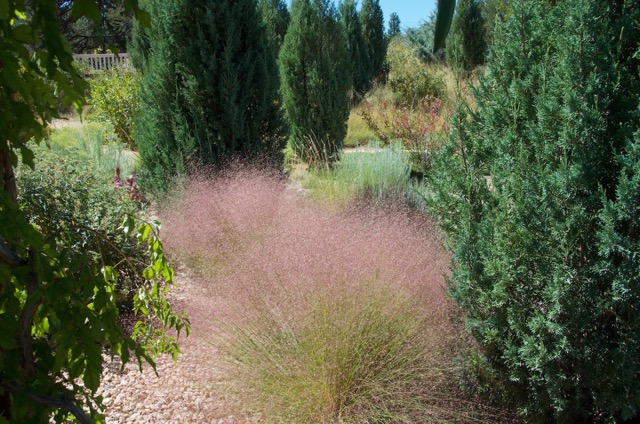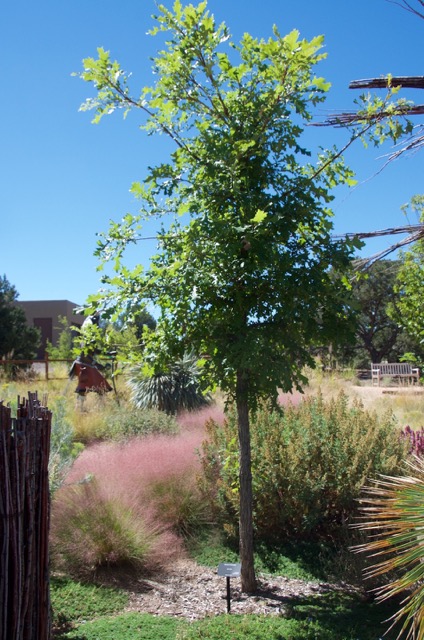Scientific name: Muhlenbergia reverchonii ‘Autumn Embers’
Common name: ‘Autumn Embers’ muhly grass
Plant Family: Poaceae – Grass
Article and photos by Janice Tucker

Muhlenbergia reverchonii ‘Autumn Embers’ (Photo credit: Janice Tucker)
The ‘Autumn Embers’ muhly grass (Muhlenbergia reverchonii ‘Autumn Embers’) is truly a plant for all seasons.
As the earth begins to warm, signaling plants that winter is waning, ‘Autumn Embers’ grass subtly sends out green, hairy, slender, thread-like leaves. The new foliage transitions smoothly into spring by blending in with the previous season’s growth. During the spring it is content to work in harmony with other plants in the garden by providing a complementary background to the showier flowering plants. But come fall, watch out! In late summer as roses, lavenders, geraniums and other flowers begin to fade from their seasonal glory ‘Autumn Embers’ will burst upon the garden scene with eye-popping, misty clouds of pink–tinged inflorescences (flowers). As winter approaches, the pinkish inflorescences, foliage and seed heads transform into a burnished bronze, giving credence to its cultivar name of ‘Autumn Embers’. Throughout the colder months it renders its warm color, texture and structure at a time of year when those characteristics of other garden plants are often absent. And then the cycle starts anew as the earth begins to send out signals that spring is approaching.
‘Autumn Embers’ is a warm season, perennial bunchgrass that grows 2 to 3 feet tall and equally as wide. It is perfectly happy either soaking up full sun or peeking out from a partially shady area. And as long as the soil has good drainage, it won’t complain. Nor is it overly thirsty, which should please water conscious Santa Fe gardeners. Harmful insects and plant diseases tend to ignore it. This versatile, compact, ornamental grass can stand alone as a prominent garden accent or grouped in a meadow or under taller plants to maximize its show of form and color. The species, Muhlenbergia reverchonii (common name “seep muhly”), is excellent for erosion control that could be an asset in a hilly area of a garden. Since ‘Autumn Embers’ muhly grass spreads primarily by seeds, not rhizomes, it is a non-competitive neighbor for companion plantings. Indeed this is a star in the landscape that does not demand a gardener’s blood, sweat and tears yet bestows year-round pleasure in exchange for minimum maintenance.
Tolerant of both drought and humid conditions, the natural habitats of the species varies from dry, rocky, limestone slopes to moderately moist hillside seeps, hence the common name of seep muhly. A native of Texas and Oklahoma, Muhlenbergia reverchonii and its cultivars have been successfully introduced to many other regions within the United States, Canada and Mexico.

Muhlenbergia reverchonii ‘Autumn Embers’ underplanting (Photo credit: Janice Tucker)
Named for an American Lutheran minister and botanist of German heritage, Gotthilf Heinrich Ernst Muhlenberg (1753-1815), the Muhlenbergia genus contains about 70 species of grasses, commonly referred to as “muhlys”. The species, reverchonii, honors Julien Reverchon (1837-1905), a French botanist who immigrated to Texas in the mid-1800’s.
Gardens that embrace all four seasons never lag in interest even during the bleak, cold winter months. The secret is to include plants that serve as a garden accessory during their formative stages and to step out from the shadows to perform at their full potential when at their peak. Muhlenbergia reverchonii ‘Autumn Embers’ does not skip a beat as it emerges from its supporting role into rock star status.
Thanks to Helen Woody and Jeanne Gozigian for proofreading this article.
Sources consulted:
Missouri Botanical Garden Plant Finder
USDA/NRCS Seep Muhly – Muhlenbergia reverchonii
San Marcos Growers Muhlenbergia reverchonii


